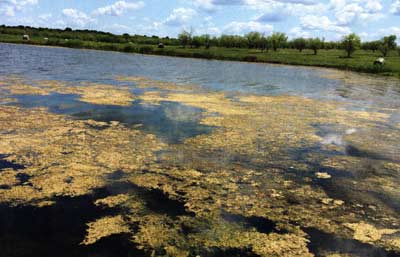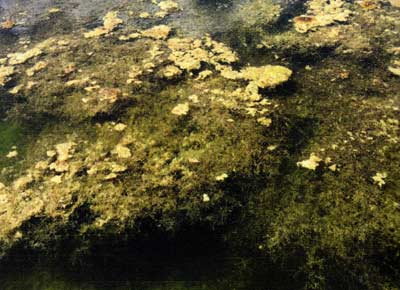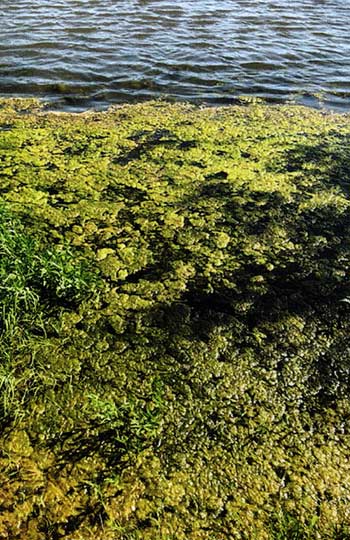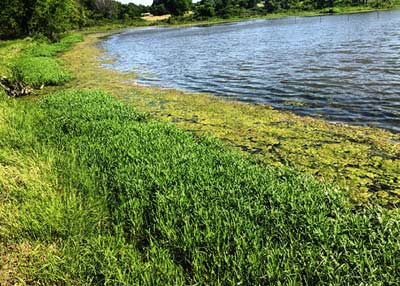
We can't go through a gorgeous spring without talking about aquatic plants, your pond's underwater salad bar.
Invariably, starting sometime in May, our phone starts ringing with calls about aquatic plants. A typical phone call goes like this, "Yes, I need some help with moss." I get emails and texts with more pictures of greenery than most people get of their grandchildren.
Each conversation, email, or text starts the same way. We identify and then quantify. For folks in the pond management business, the word moss, pond scum, or hydrilla means the same as it would if we talked to a master gardener about plants, weeds, and dirt. Or, a rancher when we say cows or horses. Those generic words might be a starting point for conversation, but we have to sift through them to find the facts.
Job One is to identify the plants correctly. Once we know the plants, we can start thinking about what to do with, for, or against them.

Job Two is to quantify. How much area do these plants cover? Are they manifested at the surface or lying low toward the bottom?
Job Three is to analyze and project what will happen.
Job Four is to formulate a plan to manage them—or not.
Back to Job One. Moss means nothing. For starters, look online at a plant identification website. A good one is Aquaplant, on the Texas A&M website, https://aquaplant.tamu.edu/plant-identification/. Another is http:// plants.ifas.ufl.edu/plant-directory/aquatic-plant-identification/ from the University of Florida. On the Pond Boss website, you can order a card deck of aquatic plants with photos and descriptions.
Once we know the plant species, we can predict what to expect in your water. For example, if you've seen your mats of vegetation getting progressively denser and thicker over the past few years, we can tell you what to expect if left unchecked.
Job Two is to quantify. That means estimating the surface area where plants are growing and how much of the mass manifests at the surface. As you quantify, make sure you understand all the different species. If you have bushy pondweed in that cove, American pondweed along the dam, and curly-leaf pondweed mixed with Eurasian watermilfoil crowding your dock, you'll make different decisions.

Job Three means understanding your circumstances and conditions. For example, suppose you've identified and quantified and see that matted algae dominate your shoreline. Still, there's some thickening bushy pondweed under that mat of dead algae, with a few sprigs of coontail here and there. In that case, you'll need to better understand the consequences of the action plan you are considering. For example, if you remove the algae, you open the window for plants beneath. That might create a bigger problem than the obvious one in front of you.
Here's a critical point. The plants aren't the problem. Instead, look at them as a symptom. The true problem is that all conditions are prime for your plants to grow. I call it the "Big Three." Sunlight, food, and temperature are the components. When all three of those things come together, plants will grow. Remember earlier this spring when all your cattails were dead, tan stalks? Look at them now. It seems like it took two weeks to go from dead to fresh, green cattails taller than a teenager.
As you strategize, ask yourself if there's anything you can do to eliminate at least one of the "Big Three." Can you change the temperature? Nope. How about the food which nurtures the plants? Maybe, if you are willing to dig up shallow areas of the pond bottom. Pricey. What about sunlight penetration? That is your best preventative option. Water clarity is part of the enemy each spring. Plants won't grow where the sunlight can't penetrate. Rooted plants are the focus of this thought process. That's the reason you see rings of plants around a pond. They can only grow so far out because the sun doesn't hit the bottom beyond that depth. That fact is a perfect reason to understand the species. If that plant will only grow so deep, you may want to leave it alone.

Remember this as you analyze—plant life is essential as a habitat component. It's nursery areas for baby fish. It's a substrate for periphyton and some species of bugs. It's a way for nature to utilize nutrients sequestered in the soil. Your decisions will impact your habitat. If you have a lake full of permanent structure with diverse habitat for your fishery, taking out massive amounts of plants may be okay. But, if your plants are critical habitat components, it's better to manage them thoughtfully rather than eradicate them.
Job Four is creating your strategy. Once you identify your plants and understand how they thrive, you can deduce their opportunity in your waters. If their potential exceeds your desire to keep them, keep them in their place. If you decide to eliminate them, there are three primary ways. There are physical ways, like bringing the local high school football team over, offering a cookout, and giving them rakes to pull the stuff out on the shore. There are weed cutters on the market and special weed rakes to do the job. The next strategy is biological. That means grass carp or tilapia. Follow the laws in your state. Grass carp have a specialty diet. They can't eat what their soft, fleshy lips can't grasp and tear. Tilapia graze on algae. Beyond those methods, EPA-approved herbicides are a choice. Some of those are contact killers; others are systemic. Learn about each and figure out what to do.
In the right part of the nation, you may be far enough ahead of the growth curve in May to decrease visibility in the water via fertilization. This will block the sunlight off the bottom in deeper water.

We want some plants to grow in the water. But we don't want them to invade the biology or the way you experience your pond. You may have the best species for your water, but you can't enjoy the pond if the entire dock is surrounded. So get rid of some of it from around the dock, and promote or allow it off that point across from the dock.
Managing plants is less about managing plants than managing the conditions where the plants grow.
Use a thought process to decide what to do, and as you create your management strategy, think about both your plan's short- and long-term consequences.
Don't be the one who kills all the pondweed in the shallowest part of your pond and then complains because the wind and waves now churn up the mud and turn your precious water the color of chocolate milk. Don't be the one who takes out all the cattails next to the spillway and then is shocked when the next flooding rain erodes a dump truck load of dirt off the side of the dam and shoves it down the creek, covering the gravel bed where your flat skipping rocks hang out.
Think it through. Identify those plants, quantify the volume, and analyze what it means. Then, develop a thoughtful management strategy that helps the pond with the best consequences.
Your pond will thank you, and you won't lay awake for a few nights thinking about how to fix a problem you didn't expect.
Reprinted with permission from Pond Boss Magazine



